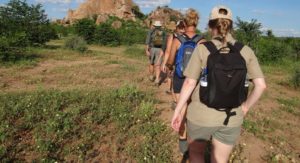How to Survive Summer Camping in Southern Africa
January 7, 2019 - 9 minutes read Southern African summers are a beautiful time of year. The skies are blue, the bush is green and there are plenty of gorgeous baby animals to swoon over. If you’re lucky, you will witness Mother Nature putting on a show of powerful thunder and lightning storms.
Southern African summers are a beautiful time of year. The skies are blue, the bush is green and there are plenty of gorgeous baby animals to swoon over. If you’re lucky, you will witness Mother Nature putting on a show of powerful thunder and lightning storms.
But one thing to keep in mind is that southern African summers can get very hot. How hot you might ask? Daytime temperatures average between the high 80s and low 100s Fahrenheit. If you’re not used to these extreme temperatures, you might wonder how you will ever survive this scorching heat. Well, if you prepare properly then you should be able to handle anything that comes your way.
EcoTraining Guides & Guardians — which offers nature and wildlife field courses in South Africa, Botswana and elsewhere on the continent — offers these 10 tips to consider when preparing for your summer camping trip in southern Africa:
1. Keep water bottles and hydration packs close by
Did you know that by the time you feel thirsty, you’re already dehydrated? Our bodies need water to survive. In summer, your water bottle and hydration pack will become your best friends and you will carry them everywhere. While you’re out on an activity, you need to plan on drinking anything from 3.5 to 5 pints of water. So please make sure that you bring reusable and washable water bottles/hydration bladders with you.
In addition to drinking plenty of water, bring re-hydration sachets or powdered/liquid sports drinks so that you can add them to your water. If you’re on a course with EcoTraining and you are experiencing any dehydration symptoms, please let the staff know so they can help. Dehydration symptoms include not urinating frequently, very dry skin, dizzy feeling, rapid breathing, lack of energy, fainting or confusion.
2. Sunscreen: reapply, reapply and reapply
The African sun is stronger than you might think. If you want to avoid looking like a lobster, always wear sunscreen and reapply it several times throughout the day. Bring at least an SPF 30 with you and keep it in your backpack at all times. This includes a high SPF lip balm as well. Don’t let cloudy days fool you — people get sunburned during cool, cloudy days, too.
3. After-sun moisturizer, lip balm, hair oil
Oops! You forgot to apply your sunscreen and now your body is a little bit sore from sunburn. Be sure to pack some after-sun or lotion to save you in a crisis like this. It can happen so easily, especially when you’re having fun and forget to reapply sunscreen. Applying hair oil also helps prevent long hair from breaking and incurring sun damage
4. The mighty insect: mosquito repellent
Mosquitoes and ticks are very active during the summer months. Insect repellent helps to keep them at bay. Whether you use natural repellent or a chemical insect repellent, it’s up to you. Depending on what you decide to use, make sure you apply in the morning when you’re going for a walk in the bush and in the evenings to help keep insects away. Remember that you need to apply your sunscreen first, give it 15-20 minutes to be absorbed into your skin, and then apply your insect repellent. If you forget to bring it, don’t panic — repellent is sold at any stores in southern Africa. While it won’t stop that annoying sound mosquitoes make, it will prevent them from biting you.
5. Select your wardrobe carefully
The sun is attracted to black, so it’s best to leave that color clothing at home. Always pack light, natural colored (beige, khaki, green and brown), loose-fitting clothing. White clothing is not preferable if you want to spot wildlife because the animals will see you from a mile away and hide. Don’t forget to protect your shoulders on game drives; always keep them  covered, as they are often the first thing to get sunburned. Also, don’t forget to bring something warm. When it rains it can become chilly and having something warm to wrap up in is a must!
covered, as they are often the first thing to get sunburned. Also, don’t forget to bring something warm. When it rains it can become chilly and having something warm to wrap up in is a must!
6. The right sleeping bag or cotton sleeping bag liners
You won’t need a thick winter sleeping bag for your trip. Look for a sleeping bag that is rated as being one season. These are the thinnest sleeping bags and the best suited for summer nights in southern Africa. You could also look at bringing a thin cotton sleeping bag liner for nights when it’s just too hot to use your sleeping bag, but you want some sort of cover.
7. Hats, caps and sunglasses
The African sun is really bright, so don’t forget to bring a pair of UV protection sunglasses to shield your eyes. A hat will help to protect your face from the sun and prevent your head from getting sunburned.
 8. The unacknowledged waterproofs
8. The unacknowledged waterproofs
This item is usually not at the top of anyone’s pack list for southern Africa but it’s definitely a must. Anyone who has experienced the mighty power of an African storm knows that you can go from bone dry to rain drenched in a matter of seconds. A good lightweight, waterproof jacket will help keep you dry and comfortable until the storm has passed. And don’t forget that electronic gear generally isn’t waterproof. You don’t want to have to decide between keeping your DSLR camera or yourself dry. Invest in a waterproof camera bag that you can keep in your backpack and use if it looks like it’s going to rain. Don’t worry if you forget this. Just pop into a local supermarket in southern Africa and grab some ziplock or plastic grocery bags. These aren’t as durable as a proper waterproof bag, but they will help to keep your electronic gear dry.
9. Lightweight scarfs, travel towels, bandanas, ice towels
Keep a wet absorbent scarf, towel or bandana around your neck and shoulders to help you stay cool. You could also try wetting your hat or t-shirt (just don’t wear white) to give you some instant natural cooling relief. You can also buy ice towels that you can soak in water and wrap around your neck to help keep you cooler for longer. At night, you can also consider dampening your t-shirt/towel/cotton sheet/sleeping bag liner — this will help to keep you cool and make it easier to sleep.
10. Baby/talcum powder, the solution to reduce chaffing and sweaty feet
If you thought talcum powder is just for babies, think again. Rub it over your feet before you embark on a walk or hike in the bush, as it will help keep your feet dry and stop your shoes from smelling. Try dusting some powder between your thighs — this will help reduce chafing caused from walking and make your legs feel amazing. If sleeping in a wet shirt at night doesn’t appeal to you, try sprinkling some talcum powder in your sleeping bag. It can make your bed feel cooler and will help absorb any sweat during the night.
By following some of these handy tips you should be able to get out there and enjoy all that the African bush has to offer.
Tags: Africa in the summer, South African Summers, Surviving African Heat, What to Bring to Africa
0 Comments